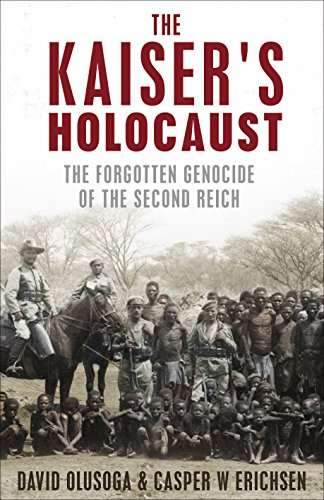
The Kaiser's Holocaust: Germany's Forgotten Genocide and the Colonial Roots of Nazism
Check my rate
| Main centres: | 1-3 business days |
| Regional areas: | 3-4 business days |
| Remote areas: | 3-5 business days |

| Main centres: | 1-3 business days |
| Regional areas: | 3-4 business days |
| Remote areas: | 3-5 business days |
Published by Faber and Faber, London, 2010, hardcover, illustrated, index, 394 pages, condition: as new.
On 12 May 1883, the German flag was raised on the coast of South-West Africa, modern Namibia a the beginnings of Germany's African Empire. As colonial forces moved in, their ruthless punitive raids became an open war of extermination. Thousands of the indigenous people were killed or driven out into the desert to die. By 1905, the survivors were interned in concentration camps, and systematically starved and worked to death.Years later, the people and ideas that drove the ethnic cleansing of German South West Africa would influence the formation of the Nazi party. The Kaiser's Holocaust uncovers extraordinary links between the two regimes: their ideologies, personnel, even symbols and uniform. The Herero and Nama genocide was deliberately concealed for almost a century. Today, as the graves of the victims are uncovered, its re-emergence challenges the belief that Nazism was an aberration in European history. The Kaiser's Holocaust passionately narrates this harrowing story and explores one of the defining episodes of the twentieth century from a new angle. Moving, powerful and unforgettable, it is a story that needs to be told.
This book, which documents a seemingly obscure place and time, is in fact the long-lost key to the origins of one of the two great catastrophes of the twentieth century.
Since the end of the Second World War and the revelation of the scale of the criminal obscenity of the so-called Final Solution, the question has been debated, is there a meaningful distinction between Nazis and Germans? Was the German nation in effect the first victim of the Nazi Party, or did the Nazi Party represent authentic aspects of the essence of the Germany of its time?
At a very fundamental level, THE KAISERS HOLOCAUST reveals the deep racism and violence inherit in the colonial ideal that was central to European global strategy in the 19th century. There are other brilliant studies, like John Elliss THE SOCIAL HISTORY OF THE MACHINE GUN and Isabel V. Hulls ABSOLUTE DESTRUCTION, which show the link between unfettered European supremecist ideas and the tragedy that unfolded in the Second Thirty Years War of 1914 1945. And there are other great studies that focus on the specifically German pathology, like Fritz Sterns THE POLITICS OF CULTURAL DESPAIR and Kevin McAleers DUELING: THE CULT OF HONOR IN FIN-DE-SIECLE GERMANY, which depict the gathering nihilism and brutality of the mood of Germanys ruling classes and structures during the Wilhelmine period.
But nowhere else is such a clinical, logical, piece-by-piece connection made between the development of political and military practices in Wilhelmine Germany and their counterparts under National Socialism. It must be said that hanging over the entire period like the smell of a corpse is a mis-application of the new science of evolutionary biology, which begins with Darwin himself, to justify the systematic subjugation and mass murder of what were considered lesser races. Once accepted, this concept was easily applied to the Jews and Slavic peoples enveloped by the German armies in their great thrust East under Operation Barbarossa.
But unfortunately, many books make clear the breadth and depth of the pagan barbarism and cruelty that saturated the culturally sophisticated and highly technological society of 19th and early 20th century Germany. These studies include John C. G. Roehls YOUNG WILHELM which shows how cruel and violent German women in the highest levels of aristocratic and royal circles could be, Isabel V. Hulls THE ENTOURAGE OF KAISER WILHELM II 1888 1918, which shows how complex and saturated the psychological and cultural manifestations of pseudo-masculinity and hyper-violence had become in elite German society before the First World War, and Ernst Juengers classic memoir of combat in World War I, STORM OF STEEL, which is nothing less that a metaphysical celebration of violence, killing and violent death.
The killing squads and murder factories of the Final Solution were merely the next administrative step in order to apply the playbook perfected in South West Africa under Kaiser Wilhelm II.